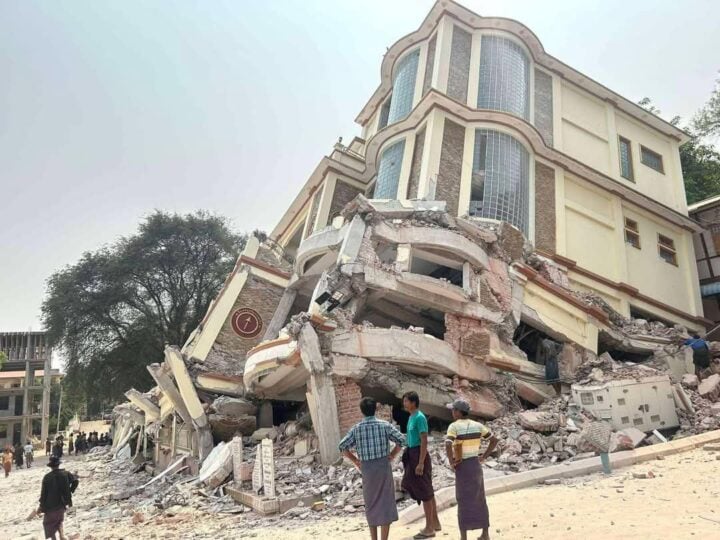The 7.7 magnitude earthquake that struck Myanmar on March 28 has caused widespread damage, affecting the Thai capital Bangkok and many other areas. Many buildings collapsed, roads were severely damaged and the death toll continues to rise.

Some buildings were damaged by the earthquake that struck Myanmar on the afternoon of March 28. Photo: GNLM.
How does an earthquake happen?
According to the United States Geological Survey (USGS), a 7.7 magnitude earthquake was recorded in Mandalay, Myanmar at noon on March 28 (local time). The epicenter was located at a depth of only about 10 km, making the level of destruction particularly severe.
The Guardian quoted Professor Bill McGuire, a geology expert at University College London, as saying: "It is highly likely that the construction quality in this area was not sufficient to withstand such strong shaking and the number of casualties will certainly continue to increase as more information about the disaster becomes available."
Causes of earthquakes
Earthquakes occur due to the movement of tectonic plates on the earth's crust. According to the USGS, the earthquake in Myanmar originated from a "slip fault" between the Indian and Eurasian plates.
"The earthquake occurred on the Sagaing Fault, the boundary between the Indian tectonic plate to the west and the Eurasian plate to the east. The Indian plate is sliding north along the fault line, rubbing against the Eurasian plate," Professor McGuire explained.
The area has recorded several large earthquakes of similar magnitude. The USGS said that since 1900, there have been six earthquakes of magnitude 7 or greater within 250 km of this epicenter.
What does the moment magnitude of an earthquake mean?
Although many people are familiar with the Richter scale, scientists now use the Moment Magnitude Scale (MMS) to determine the size of an earthquake.
"The Richter scale is outdated and only suitable for small earthquakes. It does not accurately reflect the difference in magnitude between large earthquakes," Professor McGuire explained.
The earthquake moment scale calculates magnitude based on the stiffness of the rock at the fault site, the area of the fault, and the displacement. Importantly, the scale is logarithmic, meaning that for every unit increase in magnitude, the shaking of the ground increases by a factor of 10.
"This is a major earthquake by any standard and the impact is all the more severe because the epicentre is very shallow - only about 10km. If the depth were 100km, the impact would be significantly reduced. So depth is just as important as magnitude," Professor McGuire added.
The China Earthquake Networks Center (CENC) assessed the earthquake as having a magnitude of 7.9, with tremors felt as far as Yunnan province in southwest China.
Video : Overview of the earthquake that shook Myanmar
Will earthquakes continue to occur?
"There has been a major aftershock, and others are likely to occur in the coming hours or days. These could further collapse damaged buildings, posing further danger to rescue workers," Professor McGuire warned.
Was this earthquake predictable?
"We can't predict earthquakes, so the answer is no," McGuire said. But he said the area has long been prone to earthquakes because the fault hasn't ruptured in a long time - a phenomenon known as a "seismic gap."
Dr Roger Musson, an expert at the British Geological Survey, said the last earthquake of similar magnitude in the area occurred in 1956.
"This means that most structures are not designed to withstand earthquakes, making damage and casualties more severe when disasters occur," said Mr. Musson.
In particular, the epicenter was located near Naypyidaw City, which is the second largest city in Myanmar, and affected many other densely populated areas. Therefore, casualties and damage are expected to be very large.
Source: https://nld.com.vn/nguyen-nhan-gi-gay-ra-dong-dat-kinh-hoang-tai-myanmar-196250328224118757.htm



![[Photo] General Secretary To Lam receives Chief of the Central Office of the Lao People's Revolutionary Party](https://vphoto.vietnam.vn/thumb/1200x675/vietnam/resource/IMAGE/2025/5/30/140435f4b39d4599a3d17975dfb444c5)

![[Photo] A delegation of 100 journalists from the Vietnam Journalists Association visits the soldiers and people of Truong Sa island district.](https://vphoto.vietnam.vn/thumb/1200x675/vietnam/resource/IMAGE/2025/5/30/0984a986227d4e988177f560d2e1563e)
![[Photo] Journalists moved to tears at the Memorial Service for the soldiers who died in Gac Ma](https://vphoto.vietnam.vn/thumb/1200x675/vietnam/resource/IMAGE/2025/5/30/9454613a55c54c16bf8c0efa51883456)
![[Photo] National Conference "100 years of Vietnamese Revolutionary Press accompanying the glorious cause of the Party and the nation"](https://vphoto.vietnam.vn/thumb/1200x675/vietnam/resource/IMAGE/2025/5/30/1cf6cd5c8a934ebfa347028dcb08358c)



















































































Comment (0)